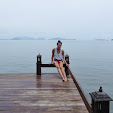Towards the end of the gap year I took between school and university, myself and my two oldest friends decided to spend a couple of weeks Interrailing across Europe. This is a hugely popular way for young people to cover a lot of ground on the Continent, allowing you to choose how many travelling days you want within a certain time frame, and picking your destinations based on that. Most continental rail lines are covered by the Interrail pass, except for the Eurostar crossing the English Channel, which allows you a lot of scope. Many non-European friends I know have undertaken mammoth tours of the continent, travelling to as many places as they possibly can, which takes commitment but can be very rewarding. For our little trio, a jaunt through central Europe was enough.
Not wanting to waste any travelling days in our own country, we bought Eurostar tickets to Paris and spent a few days there first. This was my first visit to Paris as an adult, having been to Disneyland a couple of times as well as an underwhelming weekend that involved scaling the Eiffel Tower when I was too young to particularly care. This time, I was determined to appreciate the city that has inspired people around the globe. We came armed with recommendations: get lunch at Chartiers, a cafe decorated like an old train station in the Montmartre area that proved affordable and delicious; enjoy the beautiful view from Sacré-Cœur over the Parisian rooftops; visit the Louvre, where you can get free entry with a student card, as a European citizen under 26, or as staff at an educational institution. As well as these touristy things, one of the most enjoyable parts of the Parisian leg of our trip was an afternoon spent reading in the sun at the Parc du Luxembourg. We stayed in a grungy hostel in the outer city, which was cheap and impersonal, not the community spirit you expect from youth hostels.
From Paris, we caught an overnight train to Munich and here let me give a word of advice: pay extra for a cot. Sleeping comfortably in a compartment is impossible - there is less space than you'd have on an ordinary commuter train, and there is a highly likelihood of multilingual conversations continuing throughout the night from your fellow travellers. Also, bring a scarf, sarong or pashmina everywhere you go because you never know when you'll need an impromptu blanket. Eventually we arrived in Munich, where we caught a local train to our destination, the small Bavarian town of Füssen. The landscape in this area is beautiful, and it was one of the most enjoyable train rides of my life. Füssen is a pretty basic village, the youth hostel was decent and we had our own room, and the beer was locally brewed.
But the real reason we'd ventured here was to see the building castle that inspired Disney's Sleeping Beauty castle: Schloss Neuschwanstein, a structure far more beautiful than its name would suggest. Nestled amongst the mountains and forests, it is a spectacular sight, particularly on a bright summer's day like our visit, or in the snowy winter. The interior is a bit underwhelming, being unfinished at the time of King Ludwig's demise, and there's a hell of a queue to get in, but I still say it's worth it. You also have Schloss Hohenschwangau in the area (top picture of the post), and a beautiful lake, Schwansee, at the foot of the mountain. Bavaria is a stunning part of Germany and I hope to revisit it one day. But there were many more beautiful sites to come, as from here we headed on to Austria...




No comments:
Post a Comment